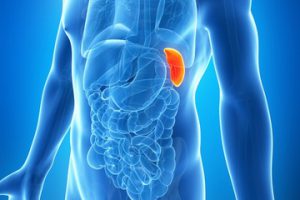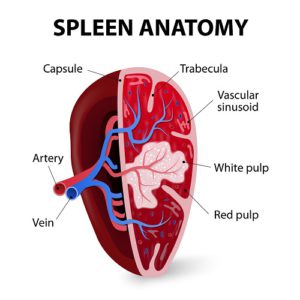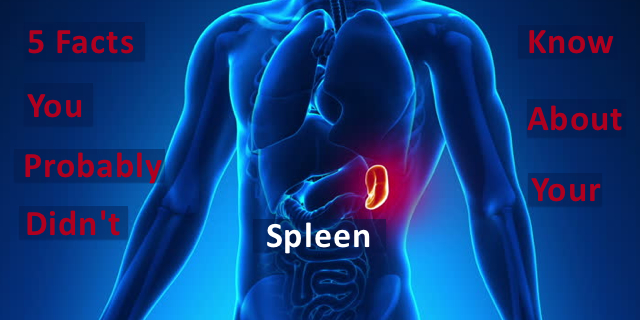Someone next to you in the elevator is coughing, sneezing and hacking away. Meanwhile, inside your body, your spleen is busily producing the lymphocytes (white blood cells) that create antibodies to attack the viruses and bacteria to which you are being exposed.
This organ is between four and five inches long (about the size of a fist) and located on the left hand  side of your body, up under your rib cage and to the left of and behind your stomach.
side of your body, up under your rib cage and to the left of and behind your stomach.
Here are some more facts you probably didn’t know about your spleen.
 Your spleen has three blood-related functions.
Your spleen has three blood-related functions.
First, it cleans your blood. It contains white blood cells called phagocytes which devour viruses, bacteria and other microorganisms. The phagocytes or macrophages also remove old red blood cells and red blood cells that are misshapen. The components of those red blood are stored and recycled by the spleen.
Second, your spleen is one of the places where B-cells and T-cells are produced and mature. These lymphocytes produce antigens that attack infecting organisms.
Third, your spleen stores one-third of the platelets in your body. Platelets are responsible for clotting of blood which stops bleeding.
 Your spleen is made of two tissues called white pulp and red pulp.
Your spleen is made of two tissues called white pulp and red pulp.
 Red pulp is the tissue involved in phagocytic activity. White pulp is the tissue where the lymphocytes reside.
Red pulp is the tissue involved in phagocytic activity. White pulp is the tissue where the lymphocytes reside.
 Mononucleosis (the “kissing disease”) is one of the infections that can enlarge your spleen.
Mononucleosis (the “kissing disease”) is one of the infections that can enlarge your spleen.
Other disorders that can cause an enlarged spleen include malaria, blood cancers like Hodgkin lymphoma and some liver diseases. When enlarged, (called splenomegagly) it is at risk of rupturing. Treating the underlying causes is much preferred to removal.
 Removal of the spleen is called a splenectomy.
Removal of the spleen is called a splenectomy.
There are number of reasons why you might need to have your spleen removed. One is trauma, like the blunt injuries that can occur during automobile accidents or while playing sports. Because of its location, such injuries can rupture your spleen. Internal bleeding can occur and can be fatal if the spleen is not removed. Pain and tenderness in the left upper quadrant of your abdomen is a symptom of a ruptured spleen and is a medical emergency.
Other conditions which may require removal of the spleen include sickle cell disease, a hereditary disorder where red blood cells are shaped like crescent moons or sickles. Ideopathic thrombocytopenia purpura is a disease of unknown origin (or ideopathic) in which platelets are destroyed by antibodies. Splenectomy may also be done for people with certain cancers.
 You can live without your spleen.
You can live without your spleen.
In some situations, like injury or disease, a splenectomy or removal of the spleen is done. Our bodies are so versatile that the spleen’s work can be picked up by the liver and bone marrow. However, people who have had to have their spleens removed must be very careful about getting infections. Living without a spleen means vigilance at the first sign of infection. But it is manageable.






Thank you for your simple posts and info!
I need help!! I have an enlarged spleen. According to my Sr it is 3x’s the size it should be. My blood work came back normal so the Dr doesn’t know why it is enlarged. It is hard for me to breath and eat. I have pain in my chest on the left side. What could be causing this and what so I do to fix it?
my mum has leukemia typhoid enlarged spleen am ten years old
May God heal you.
my aunty had an infected spleen of about 3 kilo when she removed it. after that 3-4 months she passed away , is this inherit-age ?